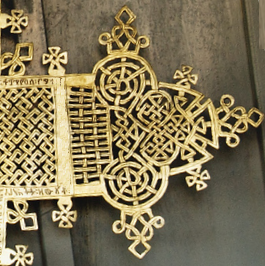Ethiopian Cross
also known as Abyssinian Cross
The cross on the left is typical of the Ethiopian Orthodox Tewahedo Church tewahedo.org
(Click image to enlarge)
European missionaries brought Christianity to many parts of Africa, in parallel with colonialism. But this was not the case with Ethiopia.
The kingdom was probably the second country (after Armenia) to embrace the Christian faith, when St. Frumentius of Tyre converted King Ezana in the 4th century. There's evidence that Christianity thrived in the country even in the 1st century and for most of the country's history since, the state religion has been Orthodox Christianity.
It comes as no surprise, therefore, that rather than the familiar European Latin Cross, the Ethiopian Cross has a distinctive 'African' appearance (see also the Coptic Cross). These are often named after the Northern Ethiopian regions and towns they are found in; for example Lalibela, Axum and Gondar.

Ethiopian crosses are almost invariably made from elaborate lattice work. Hand-held crosses usually include a square at the base, which represents the Ark of the Covenant, and both the Ark and the Cross bear the Shekinah (see Prince of Peace Cross). Geometric patterns are common in Ethiopian art and there is order and meaning in the intertwined lattice style, representing everlasting life.
The Ethiopian Orthodox Tewahedo Church is the predominant Oriental Orthodox Christian Church in Ethiopia. Being a non-Chalcedonian Church, it is not in communion with the Ethiopian Catholic Church. Tewahedo means a union. Just as in marriage two become one, in Christ his full humanity and full divinity became one. They are sometimes referred to as Monophysite (one single nature), but the Church describe themselves better as Miaphysite or Henophysite (one united nature).
When Catholics, Anglicans and others make the sign of the cross it is customary to use two fingers, with or without the thumb touching them. Two fingers and the thumb brought together represent the Holy Trinity; two fingers alone represent the two natures of Christ. Although they are touching each other, they are still separate digits. This contrasts with the intertwining construction of the Ethiopian Cross, which symbolises the mixture of the two natures.
Whether Christ is One of combined natures, or is One of parallel natures, will keep theologians busy for the next generation or so. However well-educated and intelligent we might be, there are still many things we do not know or understand.
See Proof or Faith?
There was a brief experiment with Catholicism in the 17th century when Emperor Susenyos allowed himself to be persuaded by Jesuit missionaries from Portugal – possibly a political move to help secure Portuguese and Spanish military assistance.
If that was his cunning plan, it backfired. Not only did the European soldiers fail to arrive, but the demands of Rome were just too unpalatable for the Ethiopians. Centuries of culture were threatened and many Ethiopians revolted with great loss of life. The emperor relented, expelled the missionaries, and in 1632 the state religion reverted to Ethiopian Orthodox Christianity.

